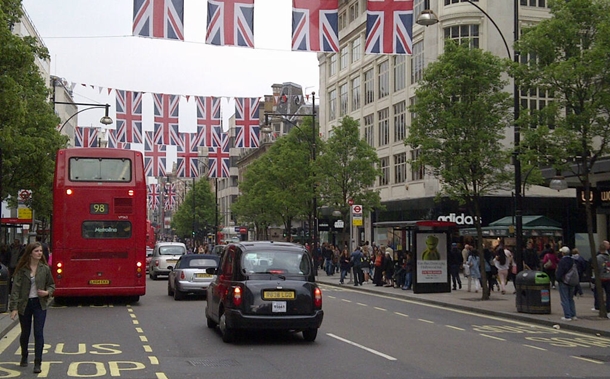 The economic policies proposed by the main parties contesting the U.K. general election do not seem too different across the political spectrum at first look.
The economic policies proposed by the main parties contesting the U.K. general election do not seem too different across the political spectrum at first look.
But a closer analysis reveals deep divisions, with some policies being labelled “idiosyncratic” by at least one economist – to use a polite term.
“Economic madness” is the less politic one employed by several commentators from different sides of the U.K. politic spectrum.
All parties agree on one thing: The economy is the key issue in the May 7 election.
It has given rise to such an avalanche of conflicting proposals and statistics that the International Monetary Fund forecast on April 15 the U.K. will still be running a budget deficit in 2020 equivalent to 0.3 percent of national income, as the organization expects weaker growth, lower tax revenue and higher spending than the parties are predicting.
All the parties have made reducing the budget deficit their headline item and there are strong similarities between Labour’s proposals and those of the coalition partners.
‘Idiosyncratic’ proposals
Reducing the deficit means making cuts, although each party ring-fences certain budgets – for Labour, it is health, education, tax credits and foreign aid, although the foreign aid budget is tiny, at around 1.4 percent of government expenditure.
The Conservatives are only promising to withhold cuts from basic education, are less clear about their plans for the National Health Service and are prepared to cut tax credits.
The SNP billboards plans for budget reduction but, at the same time, is promising to invest £140 billion ($212.9 billion) across the U.K. in public services.
The Liberals say they will get rid of the deficit by raising taxes by an additional £12 billion ($18.2 billion), cutting public spending by £12 billion ($18.2 billion) and cutting welfare by £3 billion ($4.6 billion).
For economist Jonathan Perraton, who lectures at the University of Sheffield, all of these proposals appear somewhat idiosyncratic as all of the proposals involve cuts.
“… the cuts would have to fall on those departmental budgets that have already borne the brunt … under the coalition. There is an explicit commitment to cap the welfare budget,” he pointed out in a note published on April 14.
‘Lots of cuts’
Paul Johnson, head of the Institute for Fiscal Studies, said in a note on the organization’s website: “The Conservatives want to achieve a surplus on the overall budget and so would not be happy to borrow to invest.
“That means they would need to find spending cuts of around £33 billion ($50.9 billion) after 2015-16.”
Given the ring-fencing promises, that is a lot of cuts to deliver, Johnson points out.
“Under their plans we are not even half way through the cuts,” he said in the note.
Labour, on the other hand, promises only £7 billion ($10.6 billion) in cuts, which is not much if the party’s deficit goals are to be reached, Johnson explained.
He said: “This choice between higher spending with higher debt and lower spending with lower debt may be one of the key dividing lines in the election between Labour and the Liberal Democrats on the one hand and the Conservatives on the other.
“It is therefore incumbent on each of the parties to provide the electorate with more detail on why they are advocating a particular stance, how they will achieve the required borrowing reduction and what their objectives really mean for the quality and quantity of public services and the ability of the U.K. public finances to deal with future pressures.”
Such details, according to the institute, have not been forthcoming.
Expenditure plans
But there is a more fundamental flaw in all the parties’ strategies, Perraton believes.
He said: “More fundamentally, governments do not determine the budget deficit – contrary to the impression given by much of the media and indeed politicians.
“Governments do set tax rates and expenditure plans, but the deficit (or surplus) is ultimately determined by growth in the economy.”
All the major parties have proposed a strategy for growth based on investment and public spending.
But the Conservatives, with their pledge to not raise taxes and for extreme deficit reduction, are having trouble convincing serious observers.
A study by the National Institute of Economic and Social Research published on Feb. 9 found that, owing to its looser fiscal stance, the economy would grow faster under Labour than the Conservatives.
‘Spending party’
Labour has a different challenge: seen as a “spending” party, it has not succeeded in convincing voters that its spend will be effective.
Perraton noted that the U.K. has not been very effective at raising living standards through spending on public services.
Finding the right investment opportunities for growth is difficult, he said, so difficult that even cash-rich corporations are holding back.
As for the SNP, its ambitious plans for investment are not linked to any economic data.
Nobel laureate economist Paul Krugman wrote in a recent column that voters in British elections make their choices based on recent income growth, or lack thereof.
While the U.K. economy is back in a growth phase, is this enough for the Conservatives to pull off a victory on Thursday?
‘Weak recovery’
Economist Michael Roberts wrote in a blog on April 4: “It should be, but the economic recovery under the Conservatives has been way weaker and taken longer than even I expected.
“And all these measures hide the disparities in well-being between the professional classes, particularly in London, and the rest of the population.”
Even worse, for the ruling coalition at least, growth in the first quarter dropped to 0.3 percent from the previous quarter, the slowest growth seen since 2012.
This makes a hung parliament a very likely outcome, as many pollsters predict.
Nor will the parties which eventually form a coalition find it easy to work together, given the deep differences on economic policy that divide them (Andrew Jay Rosenbaum, Anadolu Agency).

 The economic policies proposed by the main parties contesting the U.K. general election do not seem too different across the political spectrum at first look.
The economic policies proposed by the main parties contesting the U.K. general election do not seem too different across the political spectrum at first look.
